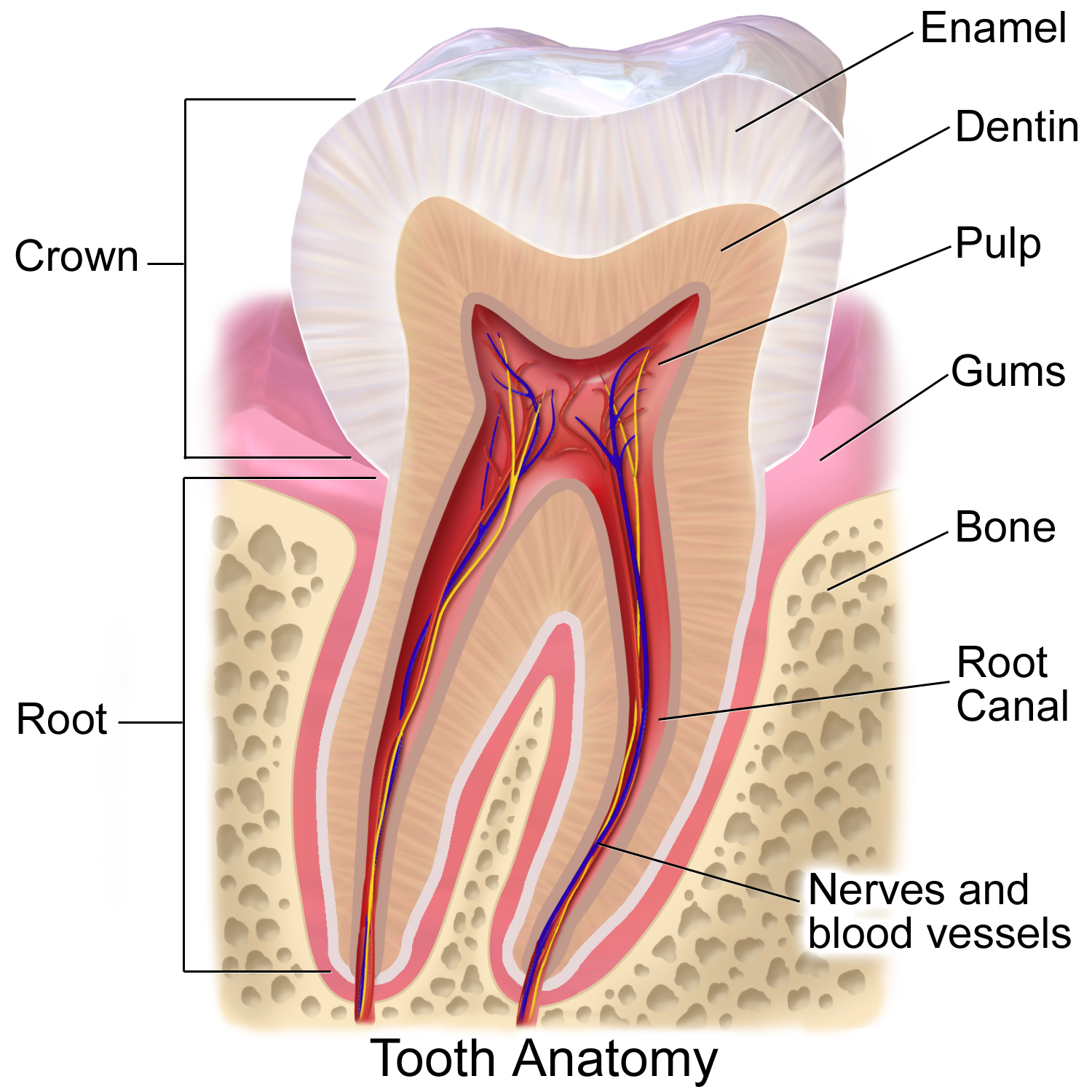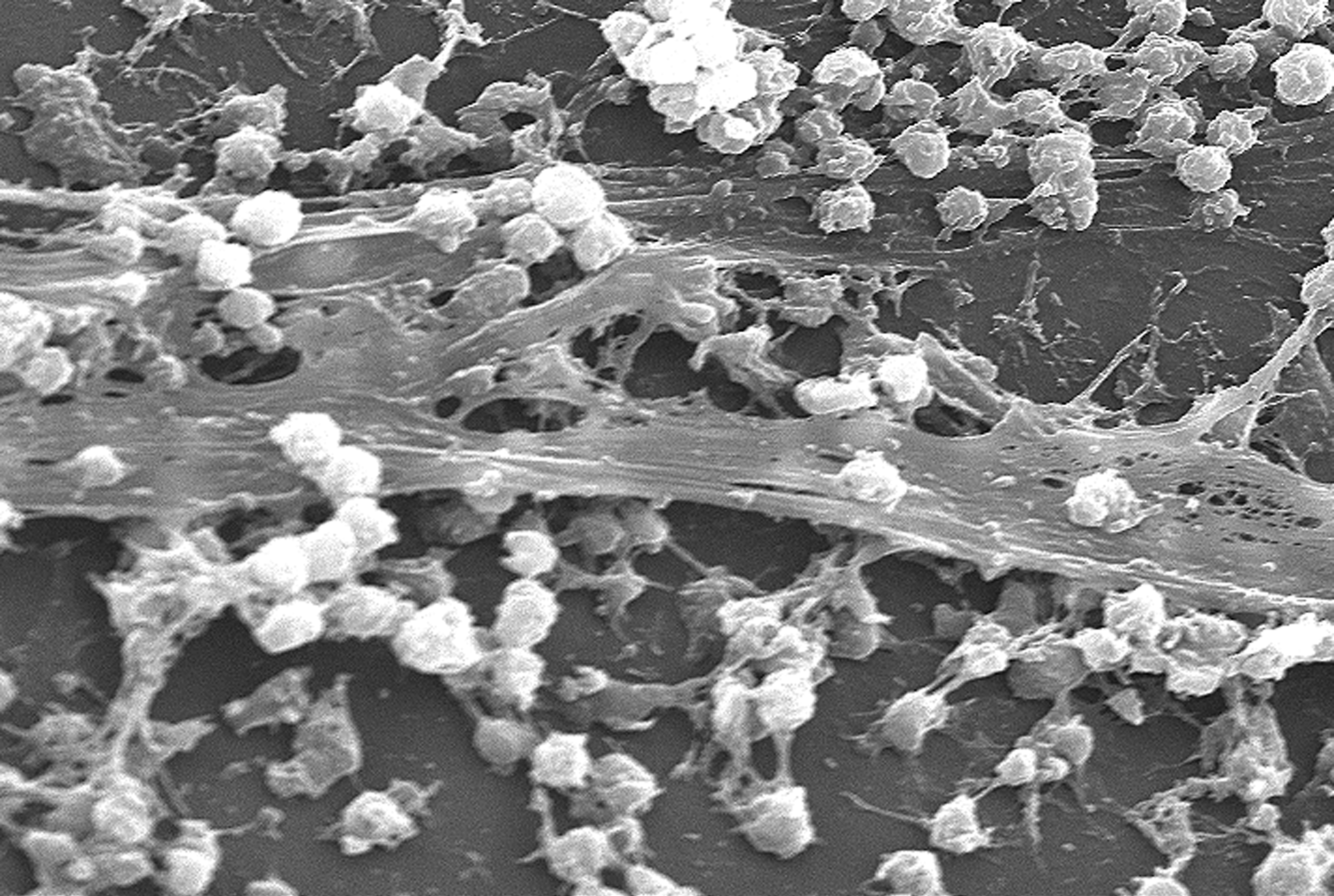|
Root Canal
A root canal is the naturally occurring anatomic space within the root of a tooth. It consists of the pulp chamber (within the coronal part of the tooth), the main canal(s), and more intricate anatomical branches that may connect the root canals to each other or to the surface of the root. Structure At the center of every tooth is a hollow area that houses soft tissues, such as the nerve, blood vessels, and connective tissue. This hollow area contains a relatively wide space in the coronal portion of the tooth called the pulp chamber. These canals run through the center of the roots, similar to the way graphite runs through a pencil. The pulp receives nutrition through the blood vessels, and sensory nerves carry signals back to the brain. A tooth can be relieved from pain if there is irreversible damage to the pulp, via root canal treatment. Root canal anatomy consists of the pulp chamber and root canals. Both contain the dental pulp. The smaller branches, referred to as '' ... [...More Info...] [...Related Items...] OR: [Wikipedia] [Google] [Baidu] |
Anatomic Space
{{set index article In anatomy, a spatium or anatomic space is a space (cavity or gap). Anatomic spaces are often landmarks to find other important structures. When they fill with gases (such as air) or liquids (such as blood) in pathological ways, they can suffer conditions such as pneumothorax, edema, or pericardial effusion. Many anatomic spaces are potential spaces, which means that they are potential rather than realized (with their realization being dynamic according to physiologic or pathophysiologic events). In other words, they are like an empty plastic bag that has not been opened (two walls collapsed against each other; no interior volume until opened) or a balloon that has not been inflated. Examples of anatomic spaces (or potential spaces) include: * Axillary space * Buccal space * Canine space * Cystohepatic triangle * Deep perineal space * Deep temporal space *Epidural space * Extraperitoneal space * Fascial spaces of the head and neck * Infratemporal space *Interco ... [...More Info...] [...Related Items...] OR: [Wikipedia] [Google] [Baidu] |
CT Scan
A computed tomography scan (CT scan), formerly called computed axial tomography scan (CAT scan), is a medical imaging technique used to obtain detailed internal images of the body. The personnel that perform CT scans are called radiographers or radiology technologists. CT scanners use a rotating X-ray tube and a row of detectors placed in a gantry (medical), gantry to measure X-ray Attenuation#Radiography, attenuations by different tissues inside the body. The multiple X-ray measurements taken from different angles are then processed on a computer using tomographic reconstruction algorithms to produce Tomography, tomographic (cross-sectional) images (virtual "slices") of a body. CT scans can be used in patients with metallic implants or pacemakers, for whom magnetic resonance imaging (MRI) is Contraindication, contraindicated. Since its development in the 1970s, CT scanning has proven to be a versatile imaging technique. While CT is most prominently used in medical diagnosis, i ... [...More Info...] [...Related Items...] OR: [Wikipedia] [Google] [Baidu] |
Dental Anatomy
Dental anatomy is a field of anatomy dedicated to the study of Tooth (human), human tooth structures. The development, appearance, and classification of teeth fall within its purview. (The function of teeth as they contact one another falls elsewhere, under dental occlusion.) Tooth formation begins before birth, and the teeth's eventual Morphology (biology), morphology is dictated during this time. Dental anatomy is also a Taxonomy (general), taxonomical science: it is concerned with the naming of teeth and the structures of which they are made, this information serving a practical purpose in dental treatment. Usually, there are 20 primary ("baby") teeth and 32 permanent teeth, the last four being third molars or "wisdom teeth", each of which may or may not grow in. Among primary teeth, 10 usually are found in the maxilla (upper jaw) and the other 10 in the human mandible, mandible (lower jaw). Among permanent teeth, 16 are found in the maxilla and the other 16 in the mandible. Ea ... [...More Info...] [...Related Items...] OR: [Wikipedia] [Google] [Baidu] |
Ralph Frederick Sommer
Ralph Frederick Sommer (1898 – 1971) is known as one of the two leading pioneers in the development of endodontics. He is also noted as a pioneer in the treatment of root canal infections and the development of the root canal operation. At the University of Michigan, Sommer was a faculty member (1924–1968) as well as Chair of the Department of Endodontics at the University of Michigan The University of Michigan (U-M, U of M, or Michigan) is a public university, public research university in Ann Arbor, Michigan, United States. Founded in 1817, it is the oldest institution of higher education in the state. The University of Mi .... He also held status as the charter member and second president of the American Association of Endodontists. References ...
|
Oral And Maxillofacial Surgery
Oral and maxillofacial surgery (OMFS) is a surgical specialty focusing on reconstructive surgery of the face, facial trauma surgery, the Human mouth, mouth, Human head, head and neck, and jaws, as well as facial plastic surgery including cleft lip and cleft palate surgery. Specialty An oral and maxillofacial surgeon is a specialist surgery, surgeon who treats the entire Craniofacial, craniomaxillofacial complex: Anatomy, anatomical area of the Human mouth, mouth, jaws, face, and Human skull, skull, head and neck as well as associated structures. Depending upon the national jurisdiction, oral and maxillofacial surgery may require a degree in medicine, dentistry or both. United States In the U.S., oral and maxillofacial surgeons, whether possessing a single or dual degree, may further specialise after residency, undergoing additional one or two year sub-specialty oral and maxillofacial surgery fellowship training in the following areas: *Cosmetic surgery#Cosmetic surgery, C ... [...More Info...] [...Related Items...] OR: [Wikipedia] [Google] [Baidu] |
Dental Implant
A dental implant (also known as an endosseous implant or fixture) is a prosthesis that interfaces with the bone of the jaw or skull to support a dental prosthesis such as a crown (dentistry), crown, bridge (dentistry), bridge, dentures, denture, or facial prosthesis or to act as an Dental braces, orthodontic anchor. The basis for modern dental implants is a biological process called osseointegration, in which materials such as titanium or Zirconium dioxide, zirconia form an intimate bond to the bone. The implant fixture is first placed so that it is likely to osseointegrate, then a dental prosthetic is added. A variable amount of healing time is required for osseointegration before either the dental prosthetic (a tooth, bridge, or denture) is attached to the implant or an abutment (dentistry), abutment is placed which will hold a dental prosthetic or crown. Success or failure of implants depends primarily on the thickness and health of the bone and gingival tissues that surround ... [...More Info...] [...Related Items...] OR: [Wikipedia] [Google] [Baidu] |
Sodium Hypochlorite
Sodium hypochlorite is an alkaline inorganic chemical compound with the formula (also written as NaClO). It is commonly known in a dilute aqueous solution as bleach or chlorine bleach. It is the sodium salt of hypochlorous acid, consisting of sodium cations () and hypochlorite anions (, also written as and ). The anhydrous compound is unstable and may decompose explosively. It can be crystallized as a pentahydrate , a pale greenish-yellow solid which is not explosive and is stable if kept refrigerated. Sodium hypochlorite is most often encountered as a pale greenish-yellow dilute solution referred to as chlorine bleach, which is a household chemical widely used (since the 18th century) as a disinfectant and bleaching agent. In solution, the compound is unstable and easily decomposes, liberating chlorine, which is the active principle of such products. Sodium hypochlorite is still the most important chlorine-based bleach. Its corrosive properties, common availability, ... [...More Info...] [...Related Items...] OR: [Wikipedia] [Google] [Baidu] |
Biofilm
A biofilm is a Syntrophy, syntrophic Microbial consortium, community of microorganisms in which cell (biology), cells cell adhesion, stick to each other and often also to a surface. These adherent cells become embedded within a slimy extracellular matrix that is composed of extracellular polymeric substances (EPSs). The cells within the biofilm produce the EPS components, which are typically a polymeric combination of extracellular polysaccharides, proteins, lipids and DNA. Because they have a three-dimensional structure and represent a community lifestyle for microorganisms, they have been metaphorically described as "cities for microbes". Biofilms may form on living (biotic) or non-living (abiotic) surfaces and can be common in natural, industrial, and hospital settings. They may constitute a microbiome or be a portion of it. The microbial cells growing in a biofilm are physiology, physiologically distinct from planktonic cells of the same organism, which, by contrast, ... [...More Info...] [...Related Items...] OR: [Wikipedia] [Google] [Baidu] |
Anatomical Terms Of Location
Standard anatomical terms of location are used to describe unambiguously the anatomy of humans and other animals. The terms, typically derived from Latin or Greek roots, describe something in its standard anatomical position. This position provides a definition of what is at the front ("anterior"), behind ("posterior") and so on. As part of defining and describing terms, the body is described through the use of anatomical planes and axes. The meaning of terms that are used can change depending on whether a vertebrate is a biped or a quadruped, due to the difference in the neuraxis, or if an invertebrate is a non-bilaterian. A non-bilaterian has no anterior or posterior surface for example but can still have a descriptor used such as proximal or distal in relation to a body part that is nearest to, or furthest from its middle. International organisations have determined vocabularies that are often used as standards for subdisciplines of anatomy. For example, '' Termi ... [...More Info...] [...Related Items...] OR: [Wikipedia] [Google] [Baidu] |
Cheek
The cheeks () constitute the area of the face below the eyes and between the nose and the left or right ear. ''Buccal'' means relating to the cheek. In humans, the region is innervated by the buccal nerve. The area between the inside of the cheek and the teeth and gums is called the vestibule or ''buccal'' pouch or ''buccal'' cavity and forms part of the mouth. In other animals, the cheeks may also be referred to as " jowls". Structure Cheeks are fleshy in humans, the skin being suspended by the chin and the jaws, and forming the lateral wall of the human mouth, visibly touching the cheekbone below the eye. The inside of the cheek is lined with a mucous membrane (''buccal'' mucosa, part of the oral mucosa). During mastication (chewing), the cheeks and tongue between them serve to keep the food between the teeth. Clinical significance The cheek is the most common location from which a DNA sample can be taken. (Some saliva is collected from inside the mouth, e.g. using a ... [...More Info...] [...Related Items...] OR: [Wikipedia] [Google] [Baidu] |
File (tool)
A file is a tool used to remove fine amounts of material from a workpiece. It is common in woodworking, metalworking, and other similar trade and hobby tasks. Most are hand tools, made of a case hardened steel bar of rectangular, square, triangular, or round cross-section, with one or more surfaces cut with sharp, generally parallel Tine (structural), teeth. A narrow, pointed Tang (tools), tang is common at one end, to which a handle may be fitted.. A rasp is a form of file with distinct, individually cut teeth used for coarsely removing large amounts of material. Files have also been developed with abrasive surfaces, such as natural or synthetic diamond tool, diamond grains or silicon carbide, allowing removal of material that would dull or resist steel files, such as ceramic. History Early filing or rasping has prehistoric roots and grew naturally out of the blending of the twin inspirations of cutting with stone cutting tools (such as hand axes) and abrasive, abrading u ... [...More Info...] [...Related Items...] OR: [Wikipedia] [Google] [Baidu] |
Nitinol
Nickel titanium, also known as nitinol, is a metal alloy of nickel and titanium, where the two elements are present in roughly equal atomic percentages. Different alloys are named according to the weight percentage of nickel; e.g., nitinol 55 and nitinol 60. Nitinol alloys exhibit two closely related and unique properties: the shape memory effect and superelasticity (also called pseudoelasticity). Shape memory is the ability of nitinol to undergo Deformation (engineering), deformation at one temperature, stay in its deformed shape when the external force is removed, then recover its original, undeformed shape upon heating above its "transformation temperature." Superelasticity is the ability for the metal to undergo large deformations and immediately return to its undeformed shape upon removal of the external load. Nitinol can undergo elastic deformations 10 to 30 times larger than alternative metals. Whether nitinol behaves with shape memory effect or superelasticity depends on w ... [...More Info...] [...Related Items...] OR: [Wikipedia] [Google] [Baidu] |







